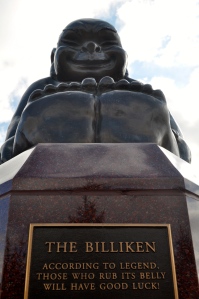
SLU students fiercely support for the currently ranked No. 18 men’s basketball team. (SLU/Allison Galoob)
With its rising basketball success, the Saint Louis University Billikens have found a place in the spotlight. Characterized by its goofy smile, the Billiken’s individuality famously confuses people.
For many years, the Billiken statue resided at the heart of campus, in front of the West Pine gym, until four years ago when it was mysteriously moved. The missing Billiken set off a frenzy of conspiracy theories and student movements. The small, yet majestic smiling Billiken is more than a mascot, he represents SLU on a much deeper level.
Topped with a tuft of hair, big eyes, a funny smile and pointy ears, the Billiken’s cryptic identity and roots raises eyebrows and questions. Determining the iconic Billiken’s identity is not easily confined to a simple explanation.
“Explaining the history behind how it became attached to the university is a tricky one because there are a few different versions of the histories,” explains senior SLU student ambassador Briana Wright. A version suggests that a St. Louis Post-Dispatch reporter dubbed the SLU football coach, Jack Bender, a strong resemblance to a Billiken. Wright continues, “We generally tend to believe that the Billiken became connected to our university after many people said our past football coach Jack Bender resembled this magical creature in 1910. From then on the team became known as “Bender’s Billikens”, and has stuck with us ever since.”

The Billiken continues to smile after 103 years of bringing luck to SLU. (SLU/Allison Galoob)
With its mysterious origins and legends, the Billiken serves its role as the school mascot and much more for the SLU community. Japanese legends proclaim the Billiken as a symbol of good luck. As a student, Dr. Dan Kozlowski “rubbed its belly for luck every time I passed it, which was a lot,” and today, he continues the tradition with the next generation of Billiken fans, “I tell my daughters to rub its belly.”
Proclaimed as one of the most unique mascots in the U.S., the Billiken does not simply symbolize luck, “Historically, it is a good luck symbol. To me, it is a funny looking, fat, little man that we use as a mascot. It symbolizes the university. I look at it and I think of SLU,” groundskeeper Tommy Wessel justifies.
The Billiken signifies a sense of purpose at SLU for Wright, “I believe that to be a Billiken means to harvest all of your uniqueness and foster your talents to go out in the world and help others in whatever way you are most passionate about.”

Senior SLU student ambassador Briana Wright prepares an information pamphlet for prospective SLU students. The “Be a Billiken” motto exemplifies SLU’s strong Billiken pride. (SLU/Allison Galoob)
Being a Billiken does not simply mean being a part of SLU’s community, but more than that. Wright illuminates, “It calls us to be appreciative of what we have and spread joy to all of the individuals around you.”
Dr. Dan Kozlowski, a former undergraduate and graduate student and current Communication professor, describes the Billiken as a symbol of “hope, social justice, caring for others, and a commitment to the Jesuit mission.” The Billiken is not simply an icon for the phenomenal SLU men’s basketball team, but a symbol of what SLU truly stands for, the Jesuit mission. Wright proclaims, “The Billiken embodies all of the uniqueness that makes up this wonderful institution. Embrace it and make it your own!”
Shortly after its disappearance, the Billiken statue reemerged near the Chafietz arena, home of the Billikens, where he continues to smile proudly. Fans, alumni, students, staff and faculty alike walk by him and rub his belly, believing and continuing the long tradition of Billiken luck.



